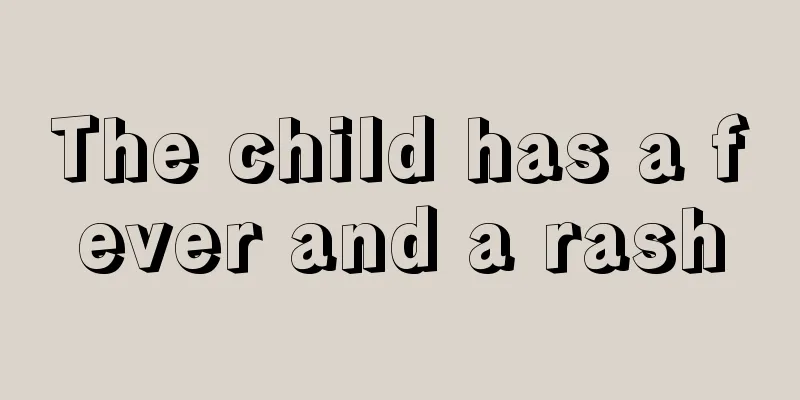Causes of leg pain in three-year-old babies

|
In our daily lives, we often hear very old people say that their legs hurt and they can’t walk anymore. We all know that this is normal. Because as they get older, some of their physical functions become worse. However, if a three-year-old child complains of leg pain, that is not normal. What is going on? Let’s take a look together! Growing pains often occur in the spring when children grow and develop rapidly before and after school age. This is mainly related to the relatively increased activity of children during this period, the rapid growth of long bones, and the uncoordinated growth and development of local muscles and tendons. Growing pains mainly manifest as pain in the limbs, most commonly in the thighs of the lower limbs. The symptoms are generally mild, mostly bilateral, and last a long time, sometimes for several months or longer. The pain mostly occurs in the afternoon and evening and disappears after a night's rest. Growing pains are a type of physiological pain and are temporary. They will heal after a period of time and do not require treatment. Since growing pains are a physiological phenomenon that occurs during children's growth and development, some parents often mistake leg pain caused by other diseases as growing pains, thus delaying the treatment of such diseases. The pain is similar to the following diseases: The cause of growing pains is still unclear. Generally, it will disappear on its own as the child grows and develops. When a child has leg pain, please distinguish it from the following types of leg pain to avoid delaying treatment: 1. Transient hip periostitis. Its symptoms are sudden leg pain, sudden inability to walk or stand after getting up in the morning, and the child has no clear history of trauma. Sometimes there are symptoms such as fever. The doctor's examination can find limited hip joint movement, X-ray examination of the hip joint is normal, and a few children have swollen hip joints. This disease is treated with hot compress, bed rest for 1-2 weeks, and oral medication. Taurine and vitamin B1 treatment. 2. Tuberculous hip arthritis: This disease is more common in preschool children. It develops slowly and is more common on one side. In the early stage of the disease, the affected limbs are sore, so the child's gait changes when walking, and the pain gradually worsens, especially when the child is awakened by pain during sleep at night. This is the main feature of this disease. 3. Femoral head necrosis: This disease has a slow onset, with severe pain and gradual lameness. There is often trauma a few weeks before the onset of the disease. The AP X-ray of the hip joint can show that the femoral head becomes smaller. This disease needs timely treatment. Delay may cause disability after hip dislocation. 4. Osteochondritis: This is an aseptic local ischemic nutritional disorder of osteochondronecrosis, which often occurs in the groin of children. This disease is more common in boys and is believed to be related to local injury caused by excessive activity. Most children have unilateral lesions, with pain that gradually worsens and limited abduction of the affected limb. Movement can aggravate the pain and the patient often suffers from limping. Nothing about children is trivial. Their studies are something that parents are particularly concerned about. But we should pay even more attention to their health. Once a child has a health problem, it is an extremely big blow. My child's leg pain is getting worse and worse. We must not be careless. Pay close attention to their normal physical condition. There are some things you don't need to take too seriously, but there are some things you must take extremely seriously. We must ensure that our children have a good body. |
<<: Reasons why children vomit after drinking water
>>: Causes and treatment of white spots on the nails of 2-year-old babies
Recommend
Transparent small blisters on baby's hands
In the hot summer, many people sweat a lot, which...
How many months is it best for babies to sit in a walker?
My eldest baby always wants to stand up with the ...
What to do if your newborn foams at the mouth
Some mothers have found that their babies often f...
Why does a child clench his teeth when sleeping?
Careful parents may find that their children grin...
Can children eat bananas when they have a fever?
Children usually cry and make a fuss when they ha...
How to treat chronic bronchitis in children?
When a child is sick, not only will the child be ...
Is hyperactivity in children due to zinc deficiency and how to supplement zinc
Recently, many children have shown signs of hyper...
What to do if your child has high uric acid
It is quite common for children to have high uric...
Newborn care
We all know that newborns have very poor physical...
Why does my child urinate frequently?
From a clinical perspective, if a child urinates ...
What should I do if my baby has a thorn on his hand?
The baby's physical health is an issue that t...
Why do children cry when they sleep at night?
As adults, after a day's work, we can really ...
What are the reasons for frequent urination in children?
Urination is a very normal physiological phenomen...
What can mothers eat to relieve breast milk jaundice?
Newborns will have jaundice within a short period...
Why is my two-month-old baby restless when sleeping at night?
Babies are the apple of their parents’ eyes. Why ...









